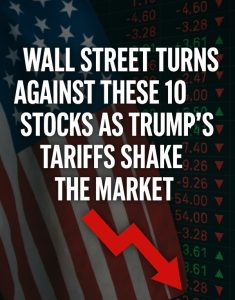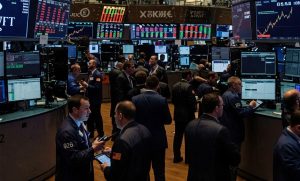Wall Street on Edge: Stocks Struggle for Direction as Tariff Worries Rattle Markets

Wall Street on Edge: Stocks Struggle for Direction as Tariff Worries Rattle Markets
The stock market experienced significant turmoil on Monday, caught in a fierce tug-of-war between buyers and sellers. As renewed concerns about tariffs emerged, volatility surged once again. Major indexes opened lower, only to claw back losses during midday trading, before fading in late-afternoon sessions. This pattern highlights the market’s ongoing struggle to establish a solid footing amidst an uncertain economic landscape.
11:15 AM ET – Rocky Start, But Buyers Lurk
Understanding Market Dynamics
To comprehend the current state of the stock market, it’s essential to analyze the key factors influencing investor sentiment. Global events, economic indicators, and policy announcements play significant roles in shaping market trajectories. For instance, historical trends have shown that geopolitical tensions often lead to increased volatility, as traders react to news and adjust their positions accordingly. Investors should remain vigilant, as the current climate may lead to rapid shifts in market direction.
In light of these developments, it’s crucial for investors to stay informed of the broader economic context. The implications of tariff discussions extend beyond immediate stock prices; they can impact supply chains, consumer behavior, and overall economic growth. Understanding these connections can empower investors to make more informed decisions and anticipate potential market shifts.
The Dow Jones Industrial Average experienced a drop of over 200 points in early trading, with sectors such as chipmakers and industrials taking the hardest hits. The S&P 500 slipped by 0.4%, while the Nasdaq Composite saw a smaller dip, maintaining some support thanks to gains in major tech companies like Apple and Amazon. This divergence in performance among sectors illustrates the complex nature of market reactions to external pressures and highlights the ongoing volatility in the tech industry.
Investors continue to digest Friday’s comments from White House officials, which hinted at potential new tariffs on key imports from Asia. The uncertainty around trade policy has thrown a wrench into what had been a cautiously optimistic outlook for the second quarter.
This recovery, however, was met with skepticism. Market analysts noted the fragility of these gains, emphasizing that investor sentiment remained vulnerable to external news and geopolitical developments. Such volatility can create opportunities for traders but also heightens risk for long-term investors who may need to reassess their strategies in this uncertain environment.
1:30 PM ET – A Midday Recovery Attempt
As the afternoon progressed, indexes made a brief attempt to recover, turning positive momentarily as dip buyers capitalized on lower prices. Treasury yields edged downwards, providing some relief to interest-rate sensitive sectors like utilities and real estate. Concurrently, crude oil prices climbed above $85 a barrel, bolstering energy stocks and signalling potential recovery for this sector.
This pattern of rise and fall underscores the importance of maintaining a diversified investment strategy. Investors are encouraged to consider sectors that may perform differently under various economic conditions, which can help mitigate risk and enhance potential returns amidst market fluctuations.
By early afternoon, the indexes briefly turned positive as dip buyers stepped in. Treasury yields inched lower, giving some relief to rate-sensitive sectors. Meanwhile, crude oil edged up above $85 a barrel, supporting energy stocks.
But sentiment remained fragile. “It’s clear the market wants to bounce, but headlines are in the driver’s seat right now,” said Jenna Foster, a senior strategist at BroadRock Partners in Chicago. “We’re seeing a classic case of headline whiplash.”
Furthermore, the anticipation of earnings season next week adds another layer of complexity to market dynamics. Companies are expected to report their first-quarter earnings amid rising costs and shifting consumer demand. The ability of these organizations to demonstrate resilience will be critical, as investor confidence heavily correlates with corporate performance during uncertain times.
3:45 PM ET – Afternoon Slump
As trading neared its conclusion, optimism dissipated rapidly. The Dow fell back near session lows, while the S&P 500 surrendered most of its earlier intraday gains. The tech-heavy Nasdaq, despite holding up better than other indexes, faced its own challenges in sustaining upward momentum, illustrating the market’s overall struggle for direction in response to ongoing news flow.
In this context, understanding sector-specific trends becomes paramount. For example, the technology sector remains particularly susceptible to tariff implications, as many companies rely on global supply chains and international markets. On the other hand, industries such as consumer staples may perform differently, offering stability during turbulent times.
As the closing bell approached, optimism faded. The Dow slid back near session lows, while the S&P 500 gave up most of its intraday gains. The tech-heavy Nasdaq held up better, but even that index struggled to maintain traction.
What’s Moving the Market?
Traders are constantly evaluating the factors keeping them on edge. The evolving landscape of trade policies, with potential new tariffs on semiconductors and electronics from China, has unnerved investors. While no official announcements have been made, the mere speculation surrounding tariffs can have profound effects on market dynamics, prompting traders to adjust their strategies proactively.
- Tariff Talk: Rumors that the U.S. may revisit tariffs on semiconductors and electronics from China have spooked investors. Though nothing has been formally announced, traders aren’t waiting to react.
- Earnings Season Ahead: Next week kicks off first-quarter earnings, and companies will be under pressure to show resilience amid rising costs and slowing demand in parts of the economy.
- Jobs Data Hangover: Friday’s robust jobs report raised fresh questions about how long the Federal Reserve will hold interest rates at current levels. Any sign of rate hikes staying “higher for longer” tends to weigh on stocks.
Sectors to Watch
Many on Wall Street are turning their attention to the upcoming CPI (Consumer Price Index) report on Wednesday. A cooler-than-expected inflation number could alleviate some pressure on the Federal Reserve, potentially paving the way for a stock rally. However, until more clarity emerges on inflation and trade policies, traders should be prepared for continued turbulence and remain proactive in their investment strategies.
- Tech: Some big names managed to stay afloat today, but the sector is vulnerable to tariff hits and broader geopolitical risks.
- Industrials: Caterpillar, Deere, and Boeing all saw heavy selling as tariff chatter often hits this group first.
- Financials: Mixed performance as banks tread water ahead of key inflation data later this week.
Investor Outlook: What Now?
Until Washington provides a definitive message and inflation shows signs of cooling, the ‘tariff tantrum’ is likely to persist, keeping Wall Street on edge. Investors are encouraged to actively seek information, analyze market trends, and adjust their portfolios accordingly, ensuring they are prepared for any eventuality in the ever-changing economic landscape.
As traders monitor the market, they are also keeping a close eye on their peers. ‘Nobody wants to be the first to declare a bottom,’ remarked Marcus Reed, who operates a small hedge fund in Boston. With trading volume light and conviction low, this environment is ripe for erratic movements. Investors should consider employing strategies that allow for flexibility and adaptability in the face of such market conditions.
Traders aren’t just watching the tape — they’re watching each other. “Nobody wants to be the first to declare a bottom,” said Marcus Reed, who runs a small hedge fund out of Boston. “Volume is light, conviction is low, and that’s a recipe for chop.”
Many on Wall Street are looking toward Wednesday’s CPI (Consumer Price Index) report for direction. A cooler-than-expected inflation number could ease some pressure on the Fed and give stocks room to rally. Until then, expect more turbulence.
Bottom Line
The prevailing mood in the market can best be characterized as nervous yet not panicked. While there’s no widespread flight to safety, there’s also no overwhelming rush towards riskier assets. Stocks are currently in a state of stagnation as traders await clearer signals regarding trade dynamics and inflation trends. Those observing the market should remain vigilant, as conditions can shift rapidly based on new information.
The market’s current mood can best be described as nervous but not panicked. While there’s no full-scale flight to safety, there’s also no stampede toward risk. Stocks are grinding in place as traders brace for more clarity on trade and inflation.
Until Washington delivers a clear message — and until inflation shows signs of cooling — the “tariff tantrum” may continue to rattle Wall Street’s nerves.






